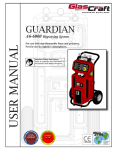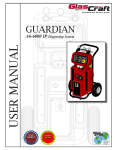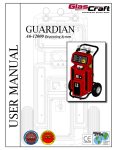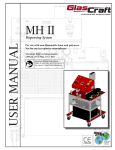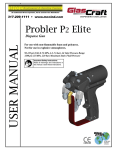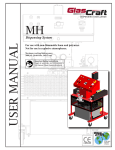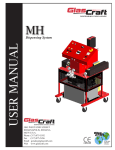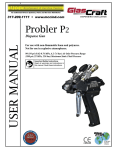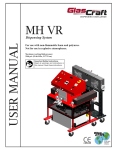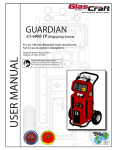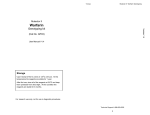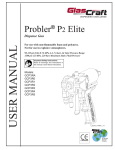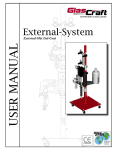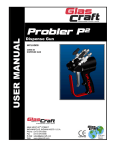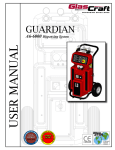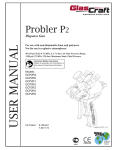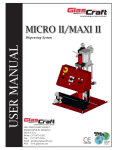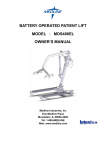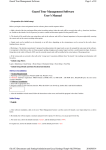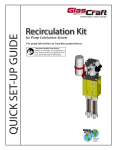Download Guardian A5-6000 System
Transcript
GUARDIAN For use with non-flammable foam and polyurea. Not for use in explosive atmospheres. Maximum fluid working pressure: (1760 psi. (12.3 MPa, 119.7 bar) M EN T IS P R CHINESE PATENT CT ED B Y HI ZL 200630130159.1 T U.S.A. PATENT D546,840 S E Q UI P T IS P R CT ED B Y HI EN TE O M TE O S E Q UI P Important Safety Instructions Read all warnings and instructions in this manual. Save these instructions. T USER MANUAL A5-6000 Dispensing System Table Of Contents Section 1 Installation Warnings ............................................................................................................................................................ Introduction ........................................................................................................................................................ Standard Equipment .......................................................................................................................................... Equipment Assembly .......................................................................................................................................... 1 5 6 7 Section 2 Operation Start-up Instructions ........................................................................................................................................... Shut–down Instructions ...................................................................................................................................... 16 19 Section 3 General Information Assembly Drawings ............................................................................................................................................. Sub Assembly Drawings ...................................................................................................................................... Maintenance ........................................................................................................................................................ Troubleshooting ................................................................................................................................................... Options ................................................................................................................................................................ 23 30 36 37 39 Section 4 Warranty and Reference Information Notes ...................................................................................................................................... 41 Technical Data ......................................................................................................................... 42 Limited Warranty Policy ............................................................................................................ 43 Technical Assistance ................................................................................................................ 44 For Your Reference ............................................................................................. INSIDE BACK COVER N/A = Non Applicable Warnings The following warnings are for the setup, use, grounding, maintenance, and repair of this equipment. The exclamation point symbol alerts you to a general warning and the hazard symbol refers to procedure-specific risk. Refer back to these warnings. Additional, product-specific warnings may be found throughout the body of this manual where applicable. WARNING ELECTRIC SHOCK HAZARD Improper grounding, setup, or usage of the system can cause electric shock. • Turn off and disconnect power cord before servicing equipment. • Use only grounded electrical outlets. • Use only 3-wire extension cords. • Ensure ground prongs are intact on sprayer and extension cords. • Do not expose to rain. Store indoors. TOXIC FLUID OR FUMES HAZARD Toxic fluids or fumes can cause serious injury or death if splashed in the eyes or on skin, inhaled, or swallowed. • Read MSDS’s to know the specific hazards of the fluids you are using. • Store hazardous fluid in approved containers, and dispose of it according to applicable guidelines. • Always wear impervious gloves when spraying or cleaning equipment. PERSONAL PROTECTIVE EQUIPMENT You must wear appropriate protective equipment when operating, servicing, or when in the operating area of the equipment to help protect you from serious injury, including eye injury, inhalation of toxic fumes, burns, and hearing loss. This equipment includes but is not limited to: • Protective eyewear • Clothing and respirator as recommended by the fluid and solvent manufacturer • Gloves • Hearing protection SKIN INJECTION HAZARD High-pressure fluid from gun, hose leaks, or ruptured components will pierce skin. This may look like just a cut, but it is a serious injury that can result in amputation. Get immediate surgical treatment. • Do not point gun at anyone or at any part of the body. • Do not put your hand over the spray tip. • Do not stop or deflect leaks with your hand, body, glove, or rag. • Close material shutoff valves when not spraying. • Follow Pressure Relief Procedure in this manual, when you stop spraying and before cleaning, checking, or servicing equipment. Warnings WARNING FIRE AND EXPLOSION HAZARD Flammable fumes, such as solvent and paint fumes, in work area can ignite or explode. To help prevent fire and explosion: • Use equipment only in well ventilated area. • Eliminate all ignition sources; such as pilot lights, cigarettes, portable electric lamps, and plastic drop cloths (potential static arc). • Keep work area free of debris, including solvent, rags and gasoline. • Do not plug or unplug power cords, or turn power or light switches on or off when flammable fumes are present. • Ground all equipment in the work area. • Use only grounded hoses. • Hold gun firmly to side of grounded pail when triggering into pail. • If there is static sparking or you feel a shock, stop operation immediately. Do not use equipment until you identify and correct the problem. • Keep a working fire extinguisher in the work area. PRESSURIZED ALUMINUM PARTS HAZARD Do not use 1,1,1-trichloroethane, methylene chloride, other halogenated hydrocarbon solvents or fluids containing such solvents in pressurized aluminum equipment. Such use can cause serious chemical reaction and equipment rupture, and result in death, serious injury, and property damage. EQUIPMENT MISUSE HAZARD Misuse can cause death or serious injury. • Do not operate the unit when fatigued or under the influence of drugs or alcohol. • Do not exceed the maximum working pressure or temperature rating of the lowest rated system component. See Technical Data in all equipment manuals. • Use fluids and solvents that are compatible with equipment wetted parts. See Technical Data in all equipment manuals. Read fluid and solvent manufacturer’s warnings. For complete information about your material, request MSDS forms from distributor or retailer. • Check equipment daily. Repair or replace worn or damaged parts immediately with genuine manufacturer’s replacement parts only. • Do not alter or modify equipment. • Use equipment only for its intended purpose. Call your distributor for information. • Route hoses and cables away from traffic areas, sharp edges, moving parts, and hot surfaces. • Do not kink or over bend hoses or use hoses to pull equipment. • Keep children and animals away from work area. • Comply with all applicable safety regulations. MOVING PARTS HAZARD Moving parts can pinch or amputate fingers and other body parts. • Keep clear of moving parts. • Do not operate equipment with protective guards or covers removed. • Pressurized equipment can start without warning. Before checking, moving, or servicing equipment, follow the Pressure Relief Procedure in this manual. Disconnect power or air supply. BURN HAZARD Equipment surfaces and fluid that’s heated can become very hot during operation. To avoid severe burns, do not touch hot fluid or equipment. Wait until equipment/fluid has cooled completely. Warnings To prevent exposing ISO to moisture: Isocyanate Hazard • Always use a sealed container with a desiccant dryer in the vent, or a nitrogen atmosphere. Never store ISO in an open container. • Keep the ISO lube pump reservoir filled with Graco Throat Seal Liquid (TSL), Part 206995. The lubricant creates a barrier between the ISO and the atmosphere. • Use moisture-proof hoses specifically designed for ISO, such as those supplied with your system. • Never use reclaimed solvents, which may contain moisture. Always keep solvent containers closed when not in use. • Never use solvent on one side if it has been contaminated from the other side. • Always park pumps when you shutdown. • Always lubricate threaded parts with Part 217374 ISO pump oil or grease when reassembling. Spraying materials containing isocyanates creates potentially harmful mists, vapors, and atomized particulates. Read material manufacturer’s warnings and material MSDS to know specific hazards and precautions related to isocyanates. Prevent inhalation of isocyanate mists, vapors, and atomized particulates by providing sufficient ventilation in the work area. If sufficient ventilation is not available, a supplied-air respirator is required for everyone in the work area. To prevent contact with isocyanates, appropriate personal protective equipment, including chemically impermeable gloves, boots, aprons, and goggles, is also required for everyone in the work area. Moisture Sensitivity of Isocyanates Isocyanates (ISO) are catalysts used in two component foam and polyurea coatings. ISO will react with moisture (such as humidity) to form small, hard, abrasive crystals, which become suspended in the fluid. Eventually a film will form on the surface and the ISO will begin to gel, increasing in viscosity. If used, this partially cured ISO will reduce performance and the life of all wetted parts. The amount of film formation and rate of crystallization varies depending on the blend of ISO, the humidity, and the temperature. Warnings Keep Components A and B Separate Changing Materials CAUTION To prevent corss-contamination of the equipment’s wetted parts, never interchange component A (isocyanate) and component B (resin) partrs. The gun is shipped with the A side on the left. The fluid manifold, fluid housing, side seal assembly, check valve cartridge, and mix chamber are marked on the A side. Foam Resins with 245 fa Blowing Agents New foam blowing agents will froth at temperatures above 90°F (33 °C) when not under pressure, especially if agitated. To reduce frothing, minimize preheating in a circulation system. • When changing materials, flush the equipment multiple times to ensure it is thoroughly clean. • Always clean the fluid inlet strainers after flushing. • Check with your material manufacturer for chemical compatibility. • Most materials use ISO on the A side, but some use ISO on the B side. • Epoxies often have amines on the B (hardener) side. Polyureas often have amines on the B (resin) side. Section 1 - Installation: Introduction Introduction The information in this document is intended only to indicate the components and their normal working relationship typical use. Each assembly should be directed by a GlasCraft distributor or made from the GlasCraft Assembly instructions provided. Before operating, maintaining or servicing any GlasCraft system, read and understand all of the technical and safety literature provided with GlasCraft products. If you do not have the proper or related manuals and safety literature for your GlasCraft system, contact your GlasCraft distributor or GlasCraft, Inc. This manual provides information for the assembly, operation, maintenance and service of this GlasCraft product as used in a typical configuration. While it lists standard specifications and procedures, some deviations may be found. In this GlasCraft technical and safety publication, the following advisories will be provided where appropriate: Information about the procedure in progress. In order to provide our users with the most up-to-date technology possible, we are constantly seeking to improve products. If a technological change occurs after a product is on the market, we will implement that technology in future production and, if practical, make it available to current users as a retrofit, update or supplement. If you find a discrepancy between your unit and the available documentation, contact your GlasCraft distributor to resolve the difference. GlasCraft, Inc. reserves the right to change or modify this product as it deems necessary. Is imperative information about equipment protection. CAUTION Indicates a hazardous situation that can result in minor or moderate injury. WARNING Careful study and continued use of this manual will provide a better understanding of the equipment and process, resulting in more efficient operation, longer trouble-free service and faster, easier troubleshooting. Indicates a hazardous situation that can result in death or serious injury. ELECTRICAL SHOCK HAZARD Indicates a hazardous situation that can result in electrical shock or serious injury. Section 1 - Installation: Standard Equipment Model - A5-6000 Part Number Description 23475- A5-6000 UNIT 23950-02 PROBLER P2 GUN 246075 POWER LOCK HEATED HOSE 246055 WHIP HOSE ASSEMBLY 23473-00 HEATER REPAIR KIT GC-1391 USER MANUAL 59934-04 DIOCTYL PHTHALATE, 1 QT. 261821 REQUIRED TO COMPLETE THE HOSE ELECTRICAL CIRCUIT. Section 1 - Installation: Equipment Assembly Guardian Line Installation Guide 2. Move material drums to the area that the equipment will be placed, ensuring that they are not sitting directly on the floor. Simply place the drums on top of a palate or similar device, so the drum bottoms will not be in contact with any cold surfaces. GlasCraft Systems are factory assembled. If any questions arise concerning air or electrical connections, please refer to illustrations located in the forward portion of this User Manual or contact your GlasCraft distributor. 3. Open all boxes that came with the machine and verify that all items are accounted for. 1. Advanced preparation 4. Lay out the 17666-05 Transfer Kit (this will come in a large bag inside the main box). a. Before beginning any installation, ensure that the applicator has the desired power supply available, (i.e. 220V single phase / 380V three phase), within 10 ft. of were the machine is to be placed. If the machine needs to be further that 10 ft. from the power supply, additional lengths of properly sized electrical cable will be required. Never use a smaller gauge size than supplied by the factory! b. Depending on the electrical setup, it may be necessary to install an appropriate plug on the end of the cable. GlasCraft will not supply this plug, as we are unaware of which style will be needed. c. Consult the data sheet for the specific unit being installed to determine the proper breaker size needed. d. You will need to run an air line to the area where the machine will be placed. consult the data sheet the specific unit being installed to determine much clean, dry air will be needed to supply the machine. If the air line is under 25 ft. use a minimum of 1/2 in. I.D. pipe or hose. If the air line is longer than 25 ft., use a minimum of 3/4 in. pipe or hose. Anything smaller than these diameters will severly affect the machine’s performance! Do not use any quick disconnect fittings on the main air line going to the machine! Check your air-compressor to make sure it is capable of suppling the maximum amount of air that the machine requires. All GlasCraft equipment is rated at 25 CFM (cubic foot per minute) 708 liters @ 90-100 psi (0.62-0.7 MPa, 6.3-7.7 BAR) do not exceed 125 PSI (0.86 MPa, 8.6 bar). Section 1 - Installation: Equipment Assembly 7. Install a male quick disconnect fitting to air inlet of 5. Remove the “red” plastic caps that cover the material both pumps. Besure to use teflon tape on the threads. inlets on the bottom of the pumps, and the air inlets on the air motor portion of the pumps. 6. Install a “y” filter to the oulet of both pumps. Besure to use teflon tape on the threads. Section 1 - Installation: Equipment Assembly 8. Remove the 2 inch bung caps on both the A and B 10. Remove the metal caps from the material pumps. side drums. Install the transfer pump collars into the bung holes, making sure to lubricate the threads with vaseline or grease, thus enabling easy removal when needed. 9. Make sure that the red caps have been removed from the bottom of the pumps and then slide the transfer pumps into the collars. Tighten the wing nuts on the collars, securing the transfer pumps in place. Loosen the 3/8 in vent plugs on both drums allowing for ventilation. If using a desiccant dryer on the A side, install it now. Section 1 - Installation: Equipment Assembly 11. Connect one end of each material hose to the inlet fittings located on the back of the machine. It is highly recommended that you label the (POLY) hose with BLUE tape and the (ISO) hose with RED tape to ensure that you don’t put the wrong transfer pump in the opposite material drum. POLY Material Drum 12. Connect the other end of the material hoses to there correct transfer pumps. Ensure that they are not reversed and tighten securely. 10 Section 1 - Installation: Equipment Assembly 13. a. Install the female quick-disconnect fittings p/n 22642-01 on to the ¼ in. air lines p/n 17798-10 that came in the transfer kit. Besure to use teflon tape on the threads. POLY Material Inlet Fitting b. Attach the quick-disconnect fittings to the male receivers on the transfer pumps. ISO Material Inlet Fitting 14. Attach the other end of the airlines to the far right regulator on the machines air manifold. ISO Material Drum 11 Section 1 - Installation: Equipment Assembly 15. If the optional scuff-jacket p/n FM-494 is being 18. Connect the 1/4 in. air line on the hose assembly to used (highly recommended, sold separately) install it over each individual section of hose before proceeding any further. Securely tape both ends of scuff jacket to the hose assembly. the air line whip hose one the front of the machine. 16. Locate the thermal couple wire protruding from the B side fitting on the front of the machine. Un-coil the wire and lay it out straight. 19. Connect the electrical wires. • Ensure the wire ends are 5/8 in. (.625 mm) long. If they are not, use a sharp pair of scissors to strip all four wire ends to the correct length. Main power from power source should be disconnected or turned off to console before making hose connections. 17. Feed the the thermal couple wire into the B side portion of the hose and pull the rest of the hose up until you can connect the hose to the front of the machine. Tighten the hose securely, being careful not to twist the hose in an “un-natural” bend. Refer to the last page in this installation guide for instructions on how to secure hoses properly. Be careful, do not cut or nick any copper strands. If more than five strands are cut or nicked, trim and re-strip the wires. New hoses are pre-stripped to the correct length; remove the insulation to expose the bare wire. 20. Ensure the strip length is correct by fitting the ferrule over the exposed wire. The ferrule should be flush with the end of the wire. 12 Section 1 - Installation: Equipment Assembly If the wire is short of the ferrule end, adjust the strip length accordingly. If bare is protruding from the ferrule, trim it flush to the end of the ferrule. To reach approximately 60 in.-lbs. (6.78 N•m), complete 4.5 revolutions with the hex wrench after the set screw contacts the ferrule. 21. Remove the ferrule and apply oxide inhibitor to the bare wire. 22. Reinsert the wire in the ferrule and apply more oxide inhibitor to the ferrule and wire end. 25. Repeat steps 21 through 24 for remaining. Re-torque all four set screws to 60 in.-lbs. (6.78 N•m), The set screws will be approxitmately flush with the connector. 26. Insert the cap plugs over the set screws. 23. Pair the electrical wires as follows: A-Hose to A-Hose B-Hose to B-Hose When connecting the first hose to the proportioner, wire painting does not make a difference. 24. Insert one wire from the heated hose into the connector. Ensure that the ferrule is mating with the connector insert and attach the set screw. Torque the set screw to 60 in.-lbs. (6.78 N•m). 27. Repeat steps 21 through 26 for additional hoses. 13 Section 1 - Installation: Equipment Assembly 28. Add extra hose lengths if necessary. Required Tools: Opened - end wrenches - 3/4 in. a. Lay hoses out straight. b. Couple hoses together with supplied union fittings and tighten finger-tight. c. • Hold crimp fitting hex (3/4 in.), and union fitting together, allowing the hose to hold its natural line. • Using 3/4 in. wrenchs to tighten swivel fitting to union, not allowing crimp fitting or union to turn. Repeat on opposite side of union. This practice is required on all connection points. 1) Hose and machine 2) Hose and gun 3) Adding additional hose sections 14 Section 1 - Installation: Equipment Assembly 29. Connect the supplied swivel fitting p/n 23825-00 to the trigger air line before attaching the hose assembly to the gun. 30. Connect hose assembly and the gun as shown. The fittings on the hose assembly are sized differently and will attach only one way. 31. Fluid and air connections between the system and gun should now be complete and tight. 32. If more than 50 ft. of hose is used the transformer tap When main power to system console is on, the white and black wires in the console are always live! Disconnect or turn off main power source before opening console to make any repairs or before making any electrical repair of any type to the system. setting will need to be set for proper hose length. The sticker on the front cover will say which tap to move the wire to. DO NOT MOVE THE COMMON LEG! If you do not understand the electrical hook-up described above, consult your local GlasCraft distributor OR a qualified electrician. Electrical connections must be checked on a periodic basis. • 208/240 volt single phase • L1 L2 GROUND • 208/240 volt three phase • L1 L2 L3 GROUND • 380 volt three phase • L1 (black) • L2 (brown) • L3 (black) • L4 (blue) • GROUND (green) 21129-01 15 1075A A 21192-01 LABEL, TRANSFORMER SIZE: (ref.): 4" X 4-1/4" COLOR: BORDER, LINES, AND TEXT - BLACK BACKGROUND - WHITE Section 2 - Operation: Start-Up Instructions Filling The System Never leave machine unattended while system power is on or system is running. System running is defined as: preheat cycle of the hose heat, primary heaters, or any pump operation. Machine operators must be familiar with the component functions and operation of the machine. 1. Adjust Air Regulator to 20 PSI to fill system. Air Motor will cycle slowly to fill Pumps, Heaters and Hoses and stop. Pre-Operation Check List A. Check that all fittings are securely tight. B. Check electrical hook-up (qualified electrician recommended). C. Main power switch on control box should be switched to OFF position. 2. Remove ISO & POLY side blocks from gun. D. Air regulator turned (counter clock-wise) to OFF position. E. Hose control and primary heater control to OFF position. Do not place any part of the body in the path of the material spray. Do not point the gun at or near other personnel. Do not look into the Mixing Chamber orifice at any time. Because of the hazardous materials used in this equipment, it is recommended that the operator use an air mask, goggles, protective clothing, and other safety equipment as prescribed by current regulations, recommendations of the chemical suppliers, and the laws in the area where the equipment is being used. PROBLER P2 MAKE SURE VALVES ARE OFF Initial Start-Up Procedure With all material and air lines connected and power cable attached, the system is now ready for start-up. 16 Section 2 - Operation: Start-Up Instructions 3. Place separate clean containers under each indi- vidual side block. Slowly open material valves (black arrow forward) on each side block to allow trapped air to escape the hose and material to flow into the containers until all air is purged from the material system. 6. Clean and lubricate side blocks and seals thoroughly and re-assemble on gun. Make certain that the side block screws are tighten securely. 7. Refer to material manufacturers operating instructions for proper preparation of material, i.e, mixers, etc. 8. Leave air regulator at 20 PSI 9. Turn main power Switch to ON position. Remember to dispense one to two gallons of material to clear the system of grease and plasticizer that was used during factory testing. 4. Close manual material valves. Material pressure gauges should now register approximately equal pressure. If one side registers considerably more pressure than the other side, go to the high pres- sure side and bleed off some pressure by slightly opening the manual material valve on the side block over the container. Bleed pressure until both sides are approximately the same pressure. 10. Turn on Hose Control: a. Push in the green power button. b. Press up or down arrow buttons on the controller until desired temperature setting is achieved. 5. Dispose of waste material properly and in accordance with chemical suppliers instructions and local, state and federal regulations. Before re-assembling side blocks, lubrication can be applied by dabbing a white lithium grease into holes inside of gun front housing and wiping grease over side block seals. Grease will purge itself when the air valve is turned on at gun and gun is triggered. 17 Section 2 - Operation: Start-Up Instructions 12. Adjust main air regulator to material suppliers 11. Turn on the ISO & POLY Heater control: specifications. a. Push in green power button. b. Press up or down arrow buttons on the controller until desired temperature setting is achieved. 13. Turn purge air and material valves ON at gun. Straighten hose out flat, to avoid uneven heating and damage to internal wiring of the Hose Assembly. Allow enough time for hose to warm up (approximately 15- 20 minutes). Remember that the heated hose does not have a delta rating. The heated hose’s function is to maintain the heat generated by the primary heaters during system operation, and preheat material during initial start-up. The hose should be set to maintain a temperature close to the set point of the heaters. ON Due to the expansion of urethanes when heated, it is imperative that on cold start-up of the system that the heaters be turned on and allowed to reach operating temperatures before the main pump air regulator is adjusted to the desired spray pressure. If you do not allow the heaters to reach operating temperature before adjusting air pressure, the material pressure will exceed the set point of the over pressure switches causing the system to shut down. OFF 14. Relieve any excess pressure by triggering the gun. The Emergency Stop Switch is located on the bottom right side of the control panel, when depressed, it will shut down the power and activate the air dump valve. To reset, turn handle on push button. 15. The system is now ready for operation. 18 Section 2 - Operation: Shut-Down Instructions Daily Shut-Down Procedure 5. Reduce main air regulator pressure to zero. 1. Turn off hose and heater controllers. 2. Turn off main power switch. 6. Visually inspect the entire system for leaks. 7. Turn off main air supply and main power. 3. Flip retract switch to the “retract position” and trigger the gun until pumps are in the down position. 4. Perform gun maintenance. (See gun manual) 19 Section 2 - Operation: Shut-Down Instructions 8. Coil heated hoses with a minimum four foot diameter 1. Remove side blocks from the gun and relieve pressure to avoid kinking and subsequent damage to the internal electrical wiring. from the system. 9. Check and lube top of the fluid section. Wipe off residual material and add a tablespoon of DOP,DBP PROBLER P2 2. Use a suitable solvent to flush the fluid circuits. To determine the compatibility of solvents with material being used. Always check with material supplier. 3. Increase transfer pump pressure until fluid movement occurs. Do not bleed fluid pressure from the system. If fluid movement does NOT occur @ 100 psi (0.7 MPa, 7 bar) of air on transfer pumps, increase main pump pressure until the main proportioner SLOWLY starts cycling. Extended Shut-Down Procedure There are many different procedures that are being followed for extended machine shut down. Because the system is designed to be compatible with most urethane formulations, GlasCraft recommends that the system should be stored with urethanes instead of solvents, plasticizers, etc. Certain considerations have to be adhered to when an extended shut-down is being performed. The following procedure is for long extended shut-down periods. 4. Once primary material is flushed from the system, reduce the main air pressure to zero or flip the retract switch to the “retract position” and trigger the gun until the pumps are in the down position. 5. If the solvent used to flush the system also contains placticizer, ensure that all primary material is flushed from the system and close the ball valves at the gun. 6. Leave the pumps in the full down stroke position with approximately 200-500 psi. (1.4-3.4 MPa, 14-35 bar) on the fluid gauges. Power should be disconnected and all air regulators turned down to zero. 7. If plasticizer is required to chase out solvent, cycle main pumps until the system is full of plasticizer, then close valves and leave the pumps in the full down stroke position with 200-500 psi. (1.4-3.4 MPa, 14-35 bar). 20 Section 2 - Operation: Shut-Down Instructions 8. Turn off main air supply and disconnect air line from 2. Adjust main air regulator to 20 psi. the system. 3. Adjust transfer pump regulators to approximately 40 psi. 9. Generously coat the exposed transfer pump shafts with lithium grease. 10. Coil the heated hoses with a minimum four foot diameter to avoid kinking and subsequent damage to the internal electrical wiring. 11. For gun shut down, follow the procedure from the gun manual. 12. The length of time a system is shut down, and the climate conditions it’s stored in will determine how often the system should be purged and refilled. Usually every 2 - 4 weeks the following procedure should be followed. 4. Remove the side blocks from the gun. Purge and Refill Procedure 1. Connect the main air line to the system. PROBLER P2 21 Section 2 - Operation: Shut-Down Instructions 5. Open both side blocks simultaneously into separate containers and dispense approximately 1-1/2 - 2 gallons of material from each side or until all plasticizer is purged from the system. Stop the pumps in the down position. Before performing any repairs on any part of the system, PLACE ALL CONTROLS ON THE MACHINE AND THE MAIN POWER SOURCE IN THE OFF POSITION AND DISCONNECT THE ELECTRICAL POWER CABLE FROM THE MAIN POWER SOURCE! 6. Close both side blocks simultaneously and wipe off residue from the side block seals. Regrease and attach both blocks to the gun. 7. Mix and properly dispose of purge material. Before performing any repairs on the system, ALL AIR and FLUID PRESSURES SHOULD BE RELIEVED TO ZERO (BLEED-OFF)! To Relieve Air And Fluid Pressures: System Console: 1. Turn OFF valves that supply material to the pumps. 2. Turn OFF main air regulator on air motor. Gun: 1. Open both Side block material valves. 2. Turn ON air switch. 3. Point gun into a clean, suitable container and trigger gun until material flow stops. 4. Fluid pressure gauges must read zero (0), if not, trigger gun until the fluid pressure gauges do read zero (0) pressure. 5. Turn OFF side block material valves. 6. Trigger gun several more times to purge any material remaining in gun. Turn OFF air switch. 7. Unless system is to be returned to service at once, follow DAILY SHUT-DOWN PROCEDURE 22 Section 3 - General Information: Assembly Drawings 23475-XX Unit Assembly 23 REVISION F Section 3 - General Information: Assembly Drawings 23475-XX Unit Assembly 24 REVISION F Section 3 - General Information: Assembly Drawings 23475-XX Parts List Part Number Description Part Number Description RS-118 ISO DECAL 3800-03 WIRE RS-119 POLY DECAL 3800-08 WIRE RS-124-01 MAIN DECAL 7208-02 WIRE NUT RS-126 HOSE CURRENT DECAL 7208-04 WIRE NUT 14638-02 RIVET 7361-00 TERMINAL LUG RING 17883-08 WIRE 7486-05 WASHER 19818-02 TERMINAL LUG 7486-28 WASHER 20188-12C SCREW 7734-06 LOCK WASHER 20188-20C SCREW 7734-10 LOCK WASHER 20188-28C SCREW 8155-64C SCREW 20895-00 CABLE 8560-03 FITTING 21094-01 ELBOW FITTING 8846-03 WIRE 21110-00 #6 WIRE 8847-08 WIRE 21129-00 TRANSFORMER DECAL 9704-11 TUBING 21150-00 TERMINAL LUG 21819-00 LIVE WIRE DECAL 21830-00 PRESSURE SWITCH 21839-00 DIN CONNECTOR 21874-00 THERMOCOUPLE 21953-32 SCREW 22178-00 ON/OFF POWER SWITCH 22502-00 CIRCULAR PANEL JACK 22509-00 CONTROL CABLE 23445-00 HEATER ASSEMBLY 23446-00 HEATER ASSEMBLY 23447-00 BOTTOM PLATE 23450-XX GUARDIAN HYBRID ASSEMBLY 23453-00 HEATER COVER 23454-00 FIBERGLASS SHELL 23457-00 CONTROL PANEL RING 23460-00 GUARDIAN PUMP ASSEMBLY 23468-00 HOSE 23469-00 RIVET NUT 23470-00 FIBER WASHER 23477-00 GUARDIAN DECAL 23478-01 CONTROL PANEL ASSEMBLY 23479- ELECTRICAL ASSEMBLY 23481-00 BLACK DECAL 3201 LUG RING 3795-00 TERMINAL LUG RING 25 REVISION F Section 3 - General Information: Assembly Drawings 23475-XX Generic System Schematic 26 REVISION F Section 3 - General Information: Assembly Drawings 23475-XX System Schematic 220V Single Phase 27 REVISION F Section 3 - General Information: Assembly Drawings 23475-XX System Schematic 220V Three Phase 28 REVISION F Section 3 - General Information: Assembly Drawings 23475-XX System Schematic 380V Three Phase 29 REVISION F Section 3 - General Information: Sub Assembly Drawings 23450-XX Hybrid Assembly 30 REVISION D Section 3 - General Information: Sub Assembly Drawings 23450-XX Hybrid Assembly Part Number Description Qty. RS-141-02 CORD GRIP 4 T4-161-01 CONNECTOR 1 10009-19 ELBOW FITTING 2 17702-00 PILOT LAMP 1 18101-01 FITTING 1 19507-03 AIR HOSE 1 20188-12C SCREW 14 20226-00 SET SCREW 1 21119-00 TRANSFORMER 1 21145-01 VENT PLUG 7 21809-07 MATERIAL HOSE 2 21866-00 COUPLING PLATE 1 21886-00 LAMP MOUNTING BLOCK 1 22142-00 TRANSFORMER 1 22150-02 PILOT LIGHT 1 22162-00 CONNECTOR 1 22163-00 AMMETER 1 22502-00 PANEL JACK 2 Part Number Description Qty. 23448-00 HANGER 2 1017-00 FITTING 3 23451-00 HEATER COVER 2 18199-02 AIR REGULATOR 2 23452-00 AMMETER BRACKET 1 18318-02 AIR GAUGE 2 23455-00 2 WHEEL CART 1 18318-04 AIR GAUGE 1 23462-00 FITTING 2 20655-04 ELBOW FITTING 1 23463-00 BULKHEAD NUT 2 21666-01 BALL VALVE 1 23467-00 WHEEL 2 23449-00 “L” BRACKET 1 23474-00 AIR MANIFOLD 1 23459-00 AIR MANIFOLD 1 23476-00 FLUID MANIFOLD 1 398 OILER CAP 2 23482-00 MANIFOLD DECAL 1 399 OILER CAP GASKET 4 5307-01 CONDUIT NUT 4 4342-04 ELBOW FITTING 1 5307-03 CONDUIT NUT 1 6782-03 TEE FITTING 1 5363-01 COTTER PIN 2 7734-07 LOCK WASHER 2 7315-09 RUBBER GROMMET 2 8115-03 FITTING 2 7315-11 RUBBER GROMMET 1 8115-06 FITTING 2 7486-07 WASHER 4 8115-07 FITTING 1 7486-11 WASHER 1 8156-24C SCREW 2 7486-27 WASHER 5 7733-14 HEX NUT 4 7734-03 LOCK WASHER 5 7734-06 LOCK WASHER 14 7734-07 LOCK WASHER 6 1 7735-40C SCREW 8156-32C SCREW 6 8160-12F SET SCREW 4 8301-12C SCREW 4 31 REVISION D Section 3 - General Information: Sub Assembly Drawings 23478-01 Control Panel Assembly Part Number Description Qty. Part Number Description Qty. 21112-00 COUNTER 1 23486-02 FEMALE PLUG 2 21164-00 1/2 AMP FUSE 3 23486-03 FEMALE PLUG 1 21164-02 2 AMP FUSE 1 23487-02 MALE PLUG 2 MALE MALE 1 21356-02 CONTROL 3 23487-03 21823-00 DIN RAIL .875 RS-122 PRIMARY DECAL 1 21872-00 ISO DECAL 1 RS-127 HOSE CONTROL DECAL 2 21873-00 POLY DECAL 1 23070-00 PUSH BUTTON 2 21889-00 FUSEHOLDER 4 23071-00 PUSH BUTTON 3 22104-00 EMERGENCY STOP DECAL 1 23073-00 EMERGENCY STOP 1 22117-00 TERMINAL BLOCK JUMPER 2 23079-01 OPEN CONTACT BLOCK 5 22414-00 CYCLE COUNTER DECAL 1 23079-02 CLOSE CONTACT BLOCK 5 22422-01 RELAY 4 23074-00 COUPLING PLATE 6 22423-01 RELAY SOCKET 4 23075-03 “R” CAP 3 22506-00 TERMINAL 6 23075-05 ”I/O” CAP 2 22507-00 END COVER 3 23078-01 YELLOW LED 3 22753-01 OVERPRESSURE DECAL 3 23078-03 GREEN LED 2 23456-01 CONTROL PANEL 1 23076-01 YELLOW CAP 3 23076-03 GREEN CAP 2 32 REVISION C Section 3 - General Information: Sub Assembly Drawings 23479- Electrical Assembly 23479-01 23479-02 23479-02 23479-01 Part Number Description Qty Part Number Description Qty 21164-02 2 AMP FUSE 2 21164-02 2 AMP FUSE 2 21823-00 DIN RAIL 2.4 21823-00 DIN RAIL 2.4 21888-06 CIRCUIT BREAKER 3 21888-06 CIRCUIT BREAKER 1 21889-00 FUSEHOLDER 2 21888-09 CIRCUIT BREAKER 2 22119-00 FUSE BLOCK 1 21889-00 FUSEHOLDER 2 22143-00 63 AMP FUSE 1 22119-00 FUSE BLOCK 1 22146-01 SOLID STATE RELAY 1 22143-00 63 AMP FUSE 1 22146-02 SOLID STATE RELAY 2 22146-01 SOLID STATE RELAY 1 22171-01 ON/OFF SWITCH BLOCK 1 22146-02 SOLID STATE RELAY 2 22174-01 ON/OFF SWITCH BLOCK COVER 1 22171-03 ON/OFF SWITCH BLOCK 1 22201-01 MECHANICAL CONTACTOR 1 22174-03 ON/OFF SWITCH BLOCK COVER 1 22709-02 MECHANICAL CONTACTOR 1 22201-01 MECHANICAL CONTACTOR 1 23307-00 TERMINAL END CLAMP 4 22709-02 MECHANICAL CONTACTOR 1 23307-00 TERMINAL END CLAMP 4 33 Section 3 - General Information: Sub Assembly Drawings 23479- Electrical Assembly 23479-03 Part Number Description Qty 21164-02 2 AMP FUSE 2 21823-00 DIN RAIL 2.4 21888-06 CIRCUIT BREAKER 3 21889-00 FUSEHOLDER 2 22119-00 FUSE BLOCK 1 22143-00 63 AMP FUSE 1 22146-01 SOLID STATE RELAY 1 22146-02 SOLID STATE RELAY 2 22157-00 TERMINAL BLOCK 1 22158-00 TERMINAL BLOCK SPACER 2 22159-00 TERMINAL BLOCK COVER 1 22171-02 ON/OFF SWITCH BLOCK 1 22174-02 ON/OFF SWITCH BLOCK COVER 1 22201-01 MECHANICAL CONTACTOR 1 22709-02 MECHANICAL CONTACTOR 1 23307-00 TERMINAL END CLAMP 4 34 Section 3 - General Information: Sub Assembly Drawings 23445-XX ISO / 23446-XX POLY Heat Exchanger Assembly 23445-00 ISO / 23446-00 POLY Part Description Qty. Number 11021-23 PLUG 1 13076-18 O-RING 4 1 20653-00 FITTING 21068-06C SCREW 4 21074-00 THERMOCOUPLE 1 22019-00 FIRE ROD 2 22108-00 OVERTEMP SWITCH 2 22633-00 COMPRESSION SPRING 2 23442-00 HEATER FRONT CAP 1 23443-00 HEATER REAR CAP 1 23444-00 HEATER BODY 1 23483-01 ELECTRIC PLUG 2 23484-01 ELECTRIC PLUG 2 23486-01 ELECTRIC PLUG 2 23487-01 ELECTRIC PLUG 2 7734-01 LOCK WASHER 4 7734-06 LOCK WASHER 12 7959-56C SCREW 12 35 23445- REVISION F 23446- REVISION E Section 3 - General Information: Maintenance Daily Routine Maintenance 1. Visually inspect the system for leaks. 2. Check desiccant dryer beads to insure they are still purple and have not changed to pink. 3. Check and lube top of the fluid section. Wipe off residual material and add a tablespoon of DOP,DBP Weekly Maintenance 1. Place a small amount of grease on the air motor shaft. 2. See related manuals. 36 Section 3 - General Information: Troubleshooting Over Pressure Problem Correction Material Or Mechanical Problem 1. Determine if the problem is high pressure related. Troubleshooting Procedure 2. Relieve system material pressure. By following this procedure, you should be able to locate and cure problems easily. Remember, however, that a successful operator must know: 3. Turn off main power. • WHAT GOOD MATERIAL LOOKS LIKE. 4. Fix the problem area: a. Potential high pressure causes: -Restriction -Overheating material in static position -ISO filter at gun • HOW THE EQUIPMENT NORMALLY OPERATES. • WHAT PATH THE MATERIALS FOLLOW THROUGH THE EQUIPMENT. • KNOWLEDGE OF THESE TROUBLESHOOTING PROCEDURES. 5. Re-start system for operation Always start with step one, never skip any portion of these procedures. The material pressure gauges are to be used for troubleshooting purposes only. The pressures registered on one gauge will not necessarily match the other. This difference can be caused by variance in materials, temperatures, viscosities, etc. Once the power has been turned off and problem solved, and the main power is turned on again, the over pressure lighted buttons will automatically be reset. If you do not understand the electrical hook-up de scribed above, consult your local GlasCraft distributor OR a qualified electrician. 1. Identify the missing material. 2. Check the material pressure gauge on the missing material side. It is recommended that a qualified, licensed electrician should install power to the supply disconnect. a. If the missing material gauge reads HIGHER than normal, there is a RESTRICTION problem between the gauge and the Mixing Chamber tip in the Gun. You should always follow all local or national electrical codes. b. If the missing material gauge reads LOWER than normal, there is a STARVATION problem between the gauge and the material supply system. Disconnect power source BEFORE attempting any repairs or opening the Control Boxes. Access to internal parts is limited to qualified personnel ONLY! Place Main Power Switch in OFF position BEFORE disconnecting power cables. This equipment is not approved for use in hazardous locations as set forth in the National Electrical Code Article 500 and Sub-Part “S” of the OSHA Standards. Problems may be cyclic in that they will appear first on only one stroke of the Proportioning Pump. Check the pressure gauges during one of these bursts of missing materials and always stop spraying while you are getting a burst of good material. 3. Concern yourself only with the material pressure on the missing material side. In troubleshooting a STARVATION problem where the pressure gauge on the missing material side is LOWER than normal, start at the point farthest from the unit and work forward. Check the obvious and easy things first. 37 Section 3 - General Information: Troubleshooting A. MATERIAL DRUMS 1. Material in drums? 2. Material temperature? a. If the material is to cold, especially at the bottom of the drum, it will raise the viscosity of the material and stall Transfer Pumps. A. GUN 1. Side block material valve turned on? 2. Bore hole of mixing chamber clean? 3. Filter strainer screen clean? 4. Side hole in mixing chamber clean? B. OPTIONAL TRANSFER PUMP(S) 1. Is it operating? 2. Is air turned on to transfer pump? 3. Regulated pressure where it should be? 4. Severe contamination of pump shaft on isocyanate side. This indicates that the pump shaft is not being lubricated. 5. Check Filter of transfer pump. 6. Before diagnosing a faulty transfer pump, be sure and check all items just listed under Transfer Pump. B. MATERIAL TEMPERATURE 1. Too high a temperature on resin side can cause a blowing agent to pre-expand in either the hose or the primary heater. C. HOSES 1. Make sure that the Hoses are not plugged. Troubleshooting a poor spray pattern To troubleshoot a poor spray pattern, you must understand the factors that affect the spray pattern. C. FILTER ASSEMBLY 1. Check fluid filter at inlet to proportioning pumps if applicable. D. PROPORTIONING PUMPS 1. Determine whether the burst appears on the Pump’s up or down stroke. a. If burst appears on UP stroke, check UPPER ball Seat and cups. b. If burst appears on DOWN stroke, check LOWER Ball Seat Follow the procedures in the order given. Remember that repairs should be made as soon as possible. Don’t leave the unit open to air any longer than necessary, as this will lead to further problems, such as moisture entering the system and causing the isocyanate to crystallize. A. TEMPERATURE 1. Too warm a material temperature will cause a separation (fingering) in the pattern. 2. Too cold a material temperature will cause a stream effect. B. PRESSURE 1. Too high a pressure will cause excessive overspray and/or separation (fingering). 2. Too low a pressure will cause a stream effect. C. CONTAMINATION IN THE MIXING CHAMBER 1. A foreign object in the mixing chamber will cause a poor pattern. Correct problem(s) immediately! After the unit has been exposed to the atmosphere, it should be run long enough to displace the material that was in the unit when it was opened up. NEVER inspect filter assemblies at time of shut-down! 4. In troubleshooting, a restriction problem where the material pressure gauge on the missing material side is higher than normal, start at the point farthest from the unit and work backward. Check obvious and easy things first. Before performing any repairs on the gun, ALL AIR and FLUID PRESSURES SHOULD BE RELIEVED TO ZERO (BLEED-OFF)! 38 Section 3 - General Information: Options 17666-04 Diaphragm Transfer Pump Kit The transfer kit attaches the same way for both ISO & POLY side. Use teflon tape on NPT threads. 39 REVISION A Section 3 - General Information: Options 17666-05 Transfer Kit The transfer kit attaches the same way for both ISO & POLY side. Use teflon tape on NPT threads. 40 REVISION A Section 4 - Warranty and Reference Information: Notes 41 Section 4 - Warranty and Reference Information: Technical Data Material Ratio: 1:1 (Fixed) Material Viscosity: Output: 200- 2000 Centipoise (Cps) @ AMBIENT Operating Temperatures: 32º F ( 0º C ) - 180º (82 º C ) Maximum fluid working pressure: Purging: Constant 16:1 RATIO 1600 psi @ 100 psi Air Max Working PSI 1760 psi Electrical Requirements: 50 A @ 208/240 VAC,50/60 hz, Single Phase 20 A @ 208/240 VAC,50/60 hz. Three Phase 20 A @ 380 VAC, 50 hz. Three Phase Compressed Air Requirements: Base Unit: 1.0 GAL PER MINUTE – 17 CFM @ 100 psi. 1.5 GAL PER MINUTE – 24 CFM @ 100 psi. 2.0 GAL PER MINUTE – 33 CFM @ 100 psi. NOTE: As output is increased, (achieved w/ chamber size on gun or spray tip), pressure drop will be greater. Heating capability will also drop. Heaters: 6000 WATT HEATER Maximum Hose Length: 300 ft. (Each Section 50 ft. x 3/8 in. I.D.) Shipping Weight: 428 Lbs. Pumps Rated: .042 Gallons Per Cycle .159 Liters Per Cycle Note: Overpressure switches are factory set at 2200 PSI. Automatic Pneumatic, Solvent-free, Constant Overall Dimensions: 42 Section 4 - Warranty and Reference Information: Limited Warranty Policy GLASCRAFT, INC. (“GlasCraft”) warrants to the original Purchaser of GlasCraft manufactured equipment and parts, that all GlasCraft manufactured equipment and parts will conform to their published written specifications and be free of defects in workmanship and material for a period of one (1) year from the original date of installation. GlasCraft makes no warranty to anyone other than the original Purchaser. If any GlasCraft manufactured part or equipment is found to be defective in workmanship or material within the one-year period from the date of installation, as determined solely by GlasCraft, GlasCraft, in its sole discretion, will either repair or replace the defective part or equipment at GlasCraft’s cost, including freight charges both ways, or credit or refund the purchase price for the defective equipment or part. A warranty claim will be honored only when: 1. GlasCraft has been informed, in writing, of any such defect in workmanship or material within ten (10) days after discovery by the original Purchaser; 2. An official of GlasCraft has issued a return authorization number; and 3. The claimed defective equipment or part has been returned to GlasCraft by the original Purchaser, freight prepaid (with proper return authorization number(s) attached), to: GlasCraft, Inc., 5845 West 82nd Street, Suite 102, Indianapolis, IN 46278, U.S.A. This warranty shall not apply to any equipment or parts that have been altered or repaired by anyone other than GlasCraft or to defects or damage resulting from improper installation, misuse, negligence, accident, or use not specified by GlasCraft. This warranty shall not apply to any equipment where any parts or components were replaced by any parts or components not manufactured or supplied by GlasCraft. The decision by GlasCraft shall be conclusive and binding on Purchaser. GlasCraft does not warrant that any equipment or parts sold to Purchaser meet or comply with any local, state, federal, or other jurisdiction’s regulations or codes. GlasCraft does not warrant that any equipment or part sold to Purchaser, when used individually or in concert with any other part, equipment, device, component or process, does not infringe on any patent rights of any third party. GlasCraft only warrants that it has no specific knowledge of any such infringement. GlasCraft makes no warranty as to any parts or equipment manufactured by others. Purchaser shall look solely and only to the manufacturer of such parts or equipment with respect to any warranty claims. GlasCraft hereby assigns to Purchaser the original manufacturer’s warranties to all such equipment and parts, to the full extent permitted. THE AFORESAID WARRANTY IS IN LIEU OF ALL OTHER WARRANTIES, EXPRESS OR IMPLIED. SPECIFICALLY THERE ARE NO WARRANTIES OF MERCHANTABILITY OR FITNESS FOR A PARTICULAR PURPOSE, WHICH WARRANTIES ARE SPECIFICALLY DISCLAIMED. GlasCraft shall not be liable for any loss or expense resulting from damage or accidents caused by improper use or application of materials manufactured or sold by GlasCraft or its distributors or agents. UNDER NO CIRCUMSTANCES SHALL GLASCRAFT’S LIABILITY EXCEED THE AMOUNT PURCHASER PAID FOR THE CLAIMED DEFECTIVE EQUIPMENT OR PART. UNDER NO CIRCUMSTANCES SHALL GLASCRAFT BE LIABLE FOR INCIDENTAL OR CONSEQUENTIAL DAMAGES OR FOR LOST PROFITS. No action arising from or relating to any goods manufactured by or purchased from GlasCraft may be brought more than one (1) year after the cause of action accrues. 43 Section 4 - Warranty and Reference Information: Technical Assistance......... Thank You for selecting GlasCraft spray equipment Should you have any questions or need technical assistance, contact your factory authorized GlasCraft distributor. Distributor: _________________________ Phone: ____________________________ Contact: ___________________________ For any issues your distributor cannot address, the GlasCraft technical service department is always available to assist you with the operation of your spray equipment. To help our technical representatives expedite your call and better address your questions, please have the following information ready and available when you phone GlasCraft. * If your questions are not urgent, You can e-mail all correspondence to [email protected] For Air Powered Systems: Model: _____________________________ Serial number: _______________________ Air compressor size: __________________ CFM generated: _____________________ Type of spray gun: ____________________ Serial number: _______________________ Pressure at the system: Hydraulic ________ Pneumatic _________ Is your equipment: Dynamic fluid pressure: Single phase: _______ Three phase ______ ISO __________ POLY ___________ What is the inbound voltage to your equipment: ____________________ Spray gun chamber size: ______________ Material being sprayed: _______________ Temperature setting ISO: _______________ Viscosity: ISO _________ POLY ________ Temperature setting POLY: ______________ Approximate material temperature: ______ Temperature setting HOSE: _____________ 44 For Your Reference Date Purchased __________________________________________________ Distributor ______________________________________________________ ______________________________________________________ Contact ______________________________________________________ Phone ______________________________________________________ E-mail ______________________________________________________ GlasCraft manufactures a complete line of polyurethane foam and polyurea coating spray systems. If your application is in-plant or a field contractor - GlasCraft has a system package to meet your requirements. GUARDIAN - AIR POWERED / A5 & A6 SERIES EQUIPMENT . 6000 OR 12000 WATTS OF HEAT . 1600, 2200, OR 3000 PRESSURE SET-UPS AVAILABLE MH, MH II, & MH III HYDRAULIC POWERED SYSTEMS . UP TO 45 LBS / MINUTE OUTPUT . EXCELLENT PERFORMANCE AND RELIABILITY GUARDIAN MMH - MOBILE MODULAR HYDRAULIC SYSTEMS . SPECIFICALLY DESIGNED FOR ANY TYPE OF SPRAY RIG . GIVE COMPLETE UTILIZATION OF FLOOR SPACE IN MOBILE RIG PROBLER P2 SPRAY GUN . IMPINGEMENT MIX / AIR PURGE . OPTIONAL NOZZLE FOR SPRAYING STUD WALLS, POURING & STREAM JET For more information concerning any of these GlasCraft products, contact your local authorized GlasCraft distributor or visit www.glascraft.com Quality and Performance… GENUINE GLASCRAFT www.glascraft.com GC-1391 REVISION F GRACO INC. P.O. BOX 1441 MINNEAPOLIS, MN 55440-1441 Phone Toll Free Fax 612-623-6921 1-800-328-0211 612-378-3505
















































